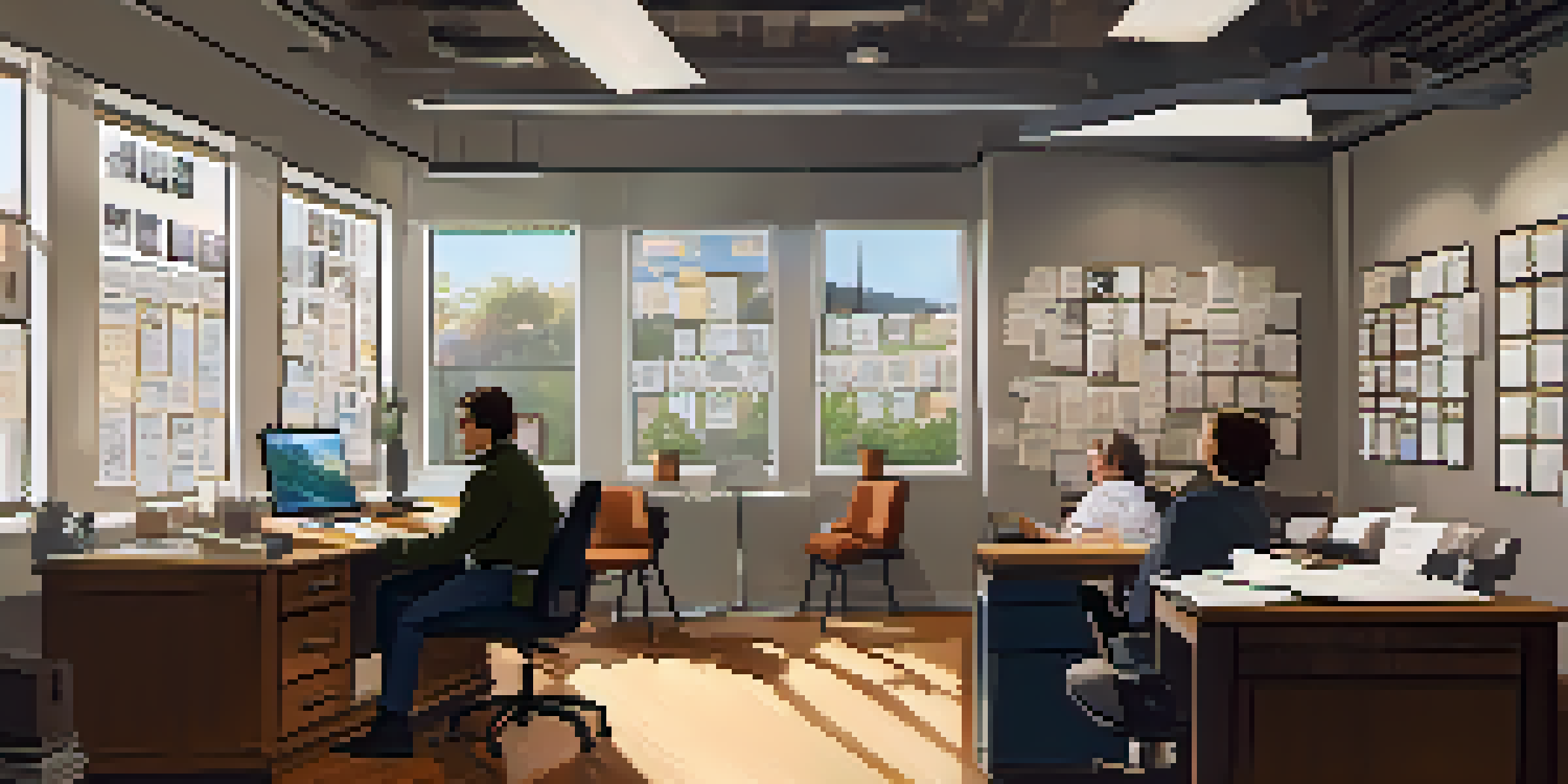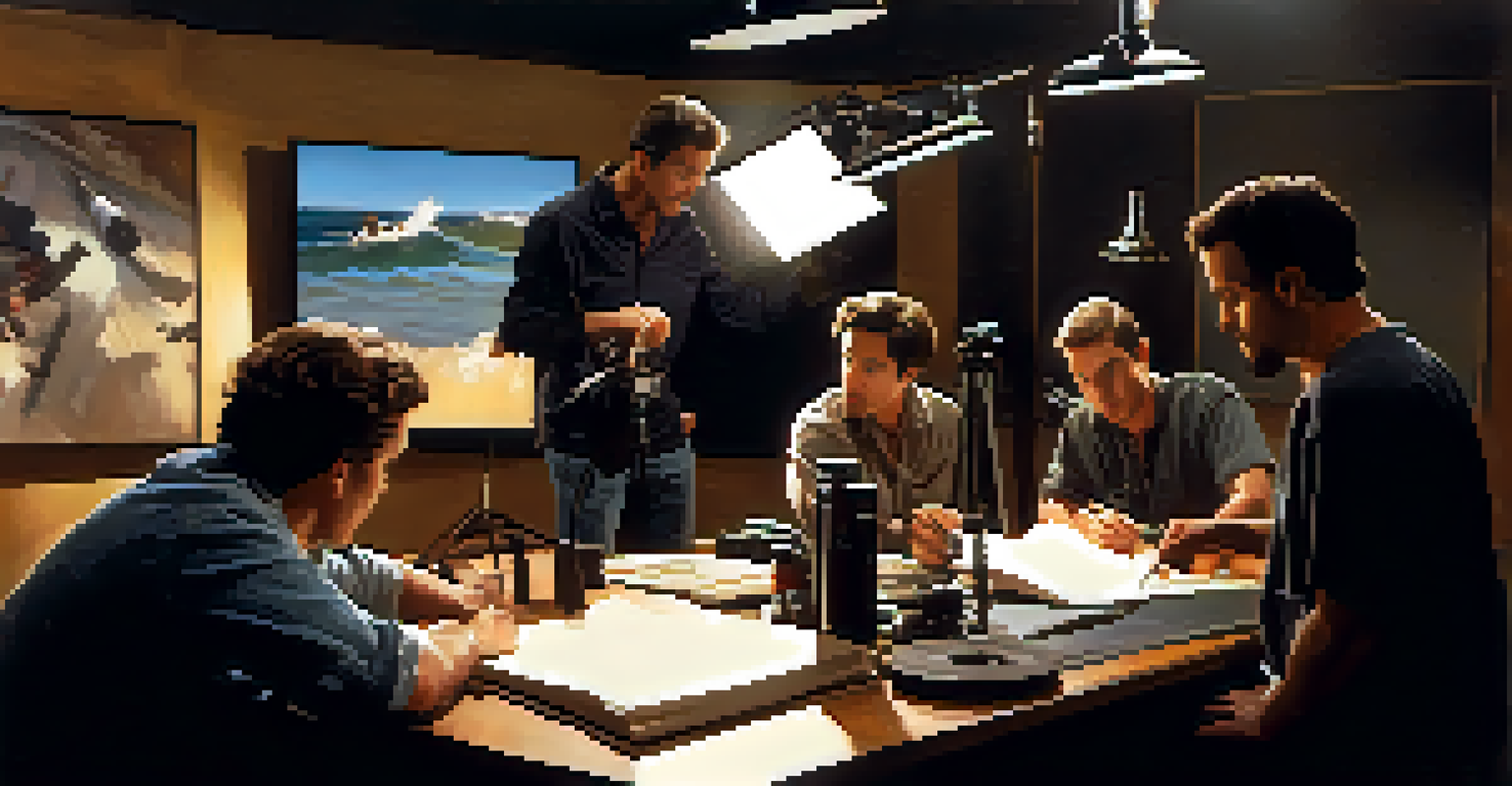The Collaboration Between Screenwriters and Directors

Understanding the Roles of Screenwriters and Directors
Screenwriters are the architects of a film, crafting the storyline, dialogue, and character arcs. They lay the groundwork that guides the entire project, ensuring that the vision is not lost. Meanwhile, directors are the builders, taking the blueprint provided by the screenwriter and bringing it to life on screen.
A good film is when the price of the dinner, the theater admission, and the babysitter were all worth it.
The collaboration between these two roles is crucial; a screenwriter’s words can inspire a director’s visual storytelling. For instance, a well-written script can evoke specific emotions that a director can then amplify through camera angles and performances. Together, they create a cohesive narrative that resonates with audiences.
Understanding each other's roles is the first step toward a successful partnership. When screenwriters and directors communicate openly about their visions and expectations, it sets the stage for a more fruitful collaboration.
The Importance of Communication in Collaboration
Effective communication is the backbone of any successful collaboration. Screenwriters and directors must engage in ongoing discussions about the project's vision, tone, and character development. This dialogue helps bridge the gap between written words and visual storytelling.

For instance, a director might have a specific vision for a scene that requires adjustments to the script. By discussing it openly, the screenwriter can adapt the dialogue or action to better fit the director's creative approach. This flexibility can lead to unexpected and exciting outcomes.
Collaboration Enhances Film Quality
The synergy between screenwriters and directors results in a cohesive narrative that captivates audiences.
Ultimately, maintaining an open line of communication fosters a creative environment where both parties feel valued and heard. This not only enhances the quality of the film but also strengthens their professional relationship.
Building Trust: A Key Element of Collaboration
Trust is fundamental in the collaboration between screenwriters and directors. Each party must feel confident in the other's abilities to bring their shared vision to life. This trust often develops over time, especially when both parties have a history of successful projects together.
The director’s job is to take the screenplay and make it real, to bring it to life on screen.
For example, directors who frequently collaborate with the same screenwriters tend to develop a deeper understanding of each other's strengths and creative processes. This familiarity allows for a more seamless integration of ideas and concepts, resulting in a more polished final product.
By establishing trust, both screenwriters and directors can take creative risks, leading to innovative storytelling. When they feel secure in their partnership, they can explore new ideas without fear of judgment, ultimately enriching the film.
Creative Differences: Navigating Conflict
Creative differences are natural in any collaborative process, especially in filmmaking. Screenwriters and directors may have different interpretations of a character or scene, leading to potential conflicts. However, navigating these differences can often lead to stronger storytelling.
For instance, a screenwriter might envision a scene with a particular emotional tone, while a director may see it differently. By discussing their perspectives and finding common ground, they can create a more nuanced scene that resonates with audiences on multiple levels.
Trust Fuels Creative Exploration
Establishing trust allows screenwriters and directors to take creative risks, leading to innovative storytelling.
Healthy conflict can spark innovation and lead to unexpected solutions. When both parties embrace differing viewpoints and work through them constructively, they can elevate the overall quality of the film.
The Role of Feedback in the Creative Process
Feedback is an essential part of the collaboration between screenwriters and directors. After a script is drafted, directors often provide input on how to enhance the storytelling aspect. This feedback loop allows the screenwriter to refine their work based on the director's vision.
For example, a director might suggest cutting a scene that doesn’t serve the overall story or adding dialogue to clarify a character’s motivation. This iterative process helps both parties hone their craft and ensures that the final product aligns with their shared vision.
By embracing feedback, screenwriters and directors can work together to create a polished and engaging film. This collaborative spirit fosters an environment of growth and creative exploration.
The Impact of Collaboration on Film Quality
The collaboration between screenwriters and directors directly affects the quality of the film. When both parties work harmoniously, the result is a more cohesive narrative that resonates with audiences. This synergy often leads to films that are not only visually stunning but also emotionally impactful.
Consider critically acclaimed films that showcase the power of collaboration—many are the result of strong partnerships between screenwriters and directors. Their ability to blend their unique perspectives often results in stories that captivate and inspire viewers.
Communication is Crucial for Success
Open dialogue between screenwriters and directors bridges the gap between script and screen, enhancing the overall project.
Ultimately, when screenwriters and directors collaborate effectively, they create a compelling cinematic experience that leaves a lasting impression on audiences. Their combined efforts elevate the film from mere storytelling to an art form.
Case Studies: Successful Collaborations
Several iconic films illustrate the successful collaboration between screenwriters and directors. For instance, the partnership of Quentin Tarantino and Roger Avary resulted in groundbreaking films like 'Pulp Fiction,' where both their unique styles complemented each other beautifully. This synergy brought to life a rich tapestry of characters and narratives.
Another notable collaboration is between the Coen Brothers, who both write and direct their films. Their ability to seamlessly blend their creative visions has led to critically acclaimed works like 'Fargo' and 'No Country for Old Men.' Their collaborative process showcases how intertwined writing and directing can lead to rich storytelling.

These examples highlight that a strong collaborative relationship can yield extraordinary results in filmmaking. The magic happens when both screenwriters and directors bring their strengths to the table, creating films that resonate with audiences worldwide.
Looking Ahead: The Future of Screenwriter-Director Partnerships
As the film industry continues to evolve, the collaboration between screenwriters and directors will remain vital. With the rise of streaming platforms and diverse storytelling formats, there are new opportunities for these creative partnerships to flourish. This evolution opens the door for innovative narratives and fresh perspectives.
Moreover, the increasing demand for original content emphasizes the importance of strong collaborations. Screenwriters and directors can work together to explore untold stories and push the boundaries of traditional filmmaking. This partnership is crucial in developing unique narratives that resonate in today’s diverse media landscape.
Ultimately, the future of film will rely heavily on the synergy between screenwriters and directors. By fostering strong partnerships, they can continue to inspire and engage audiences with compelling stories for years to come.